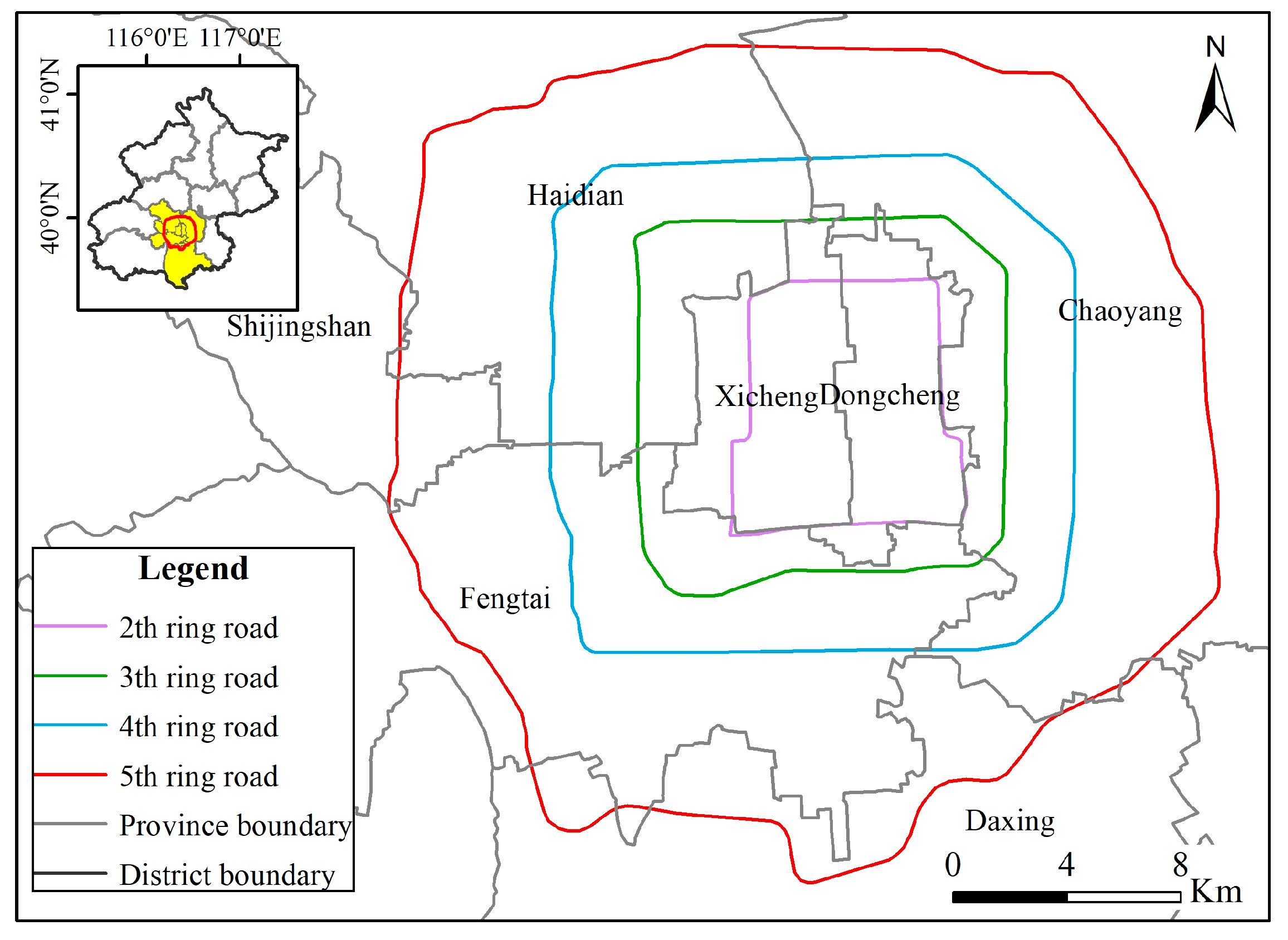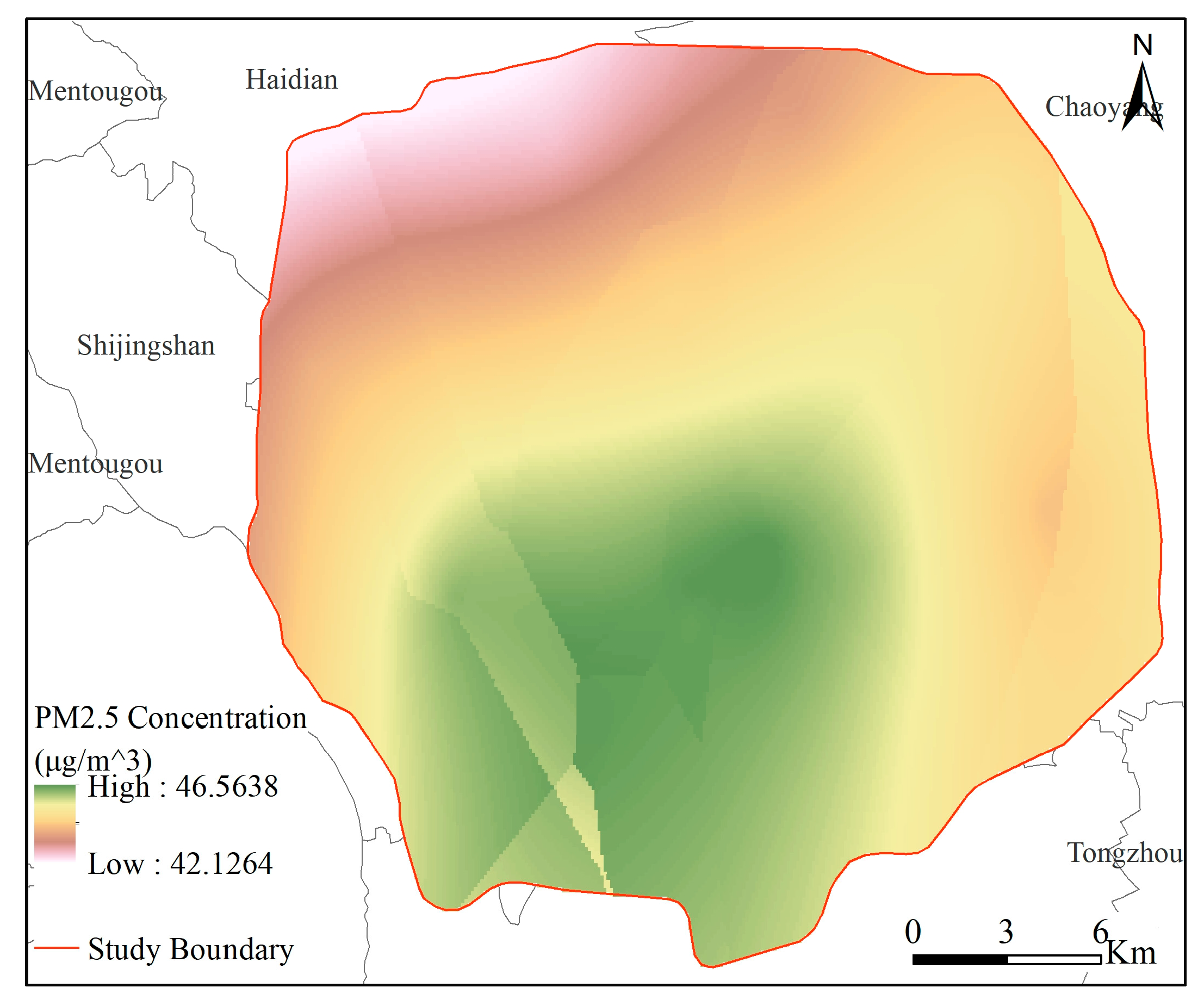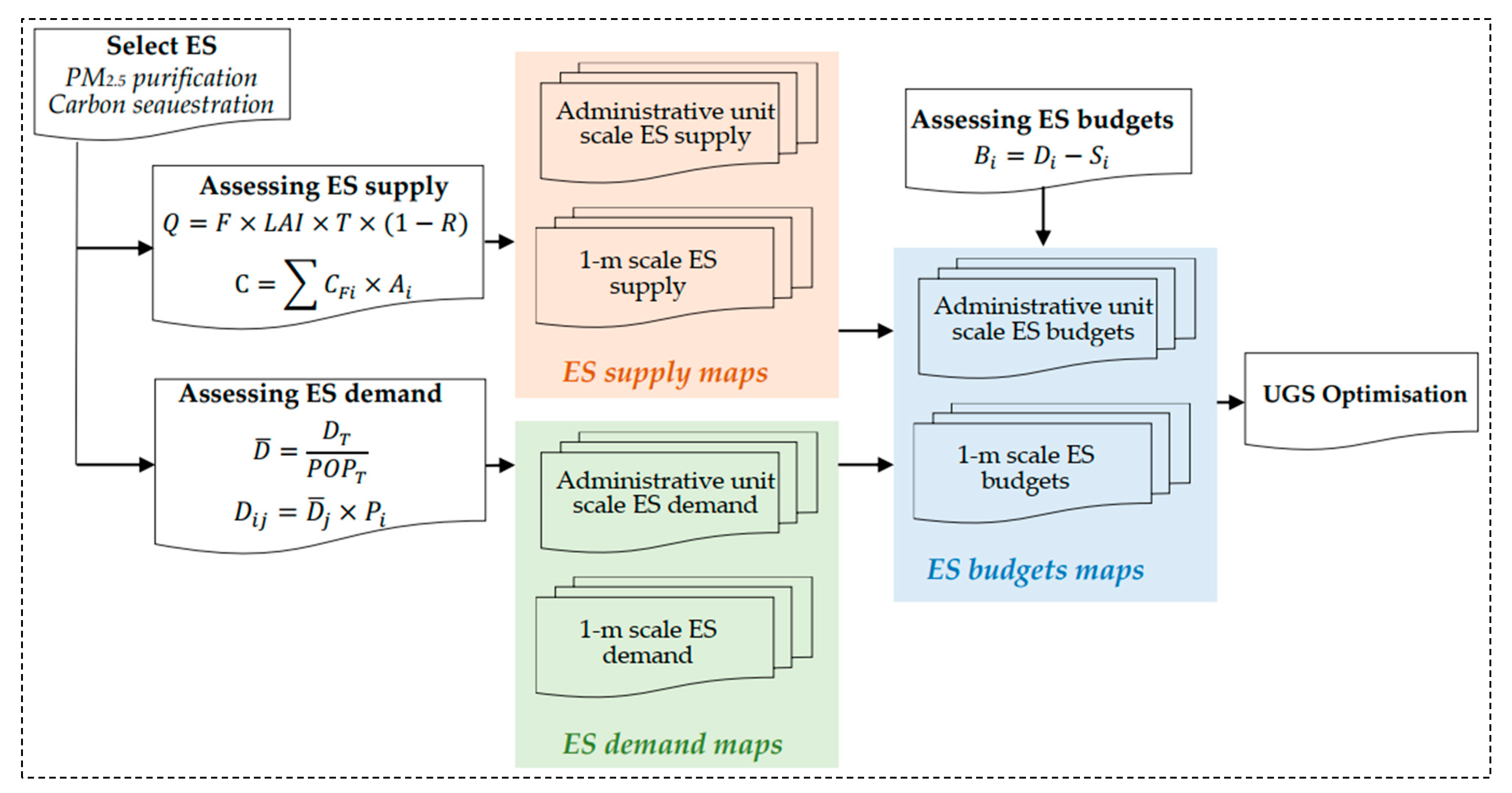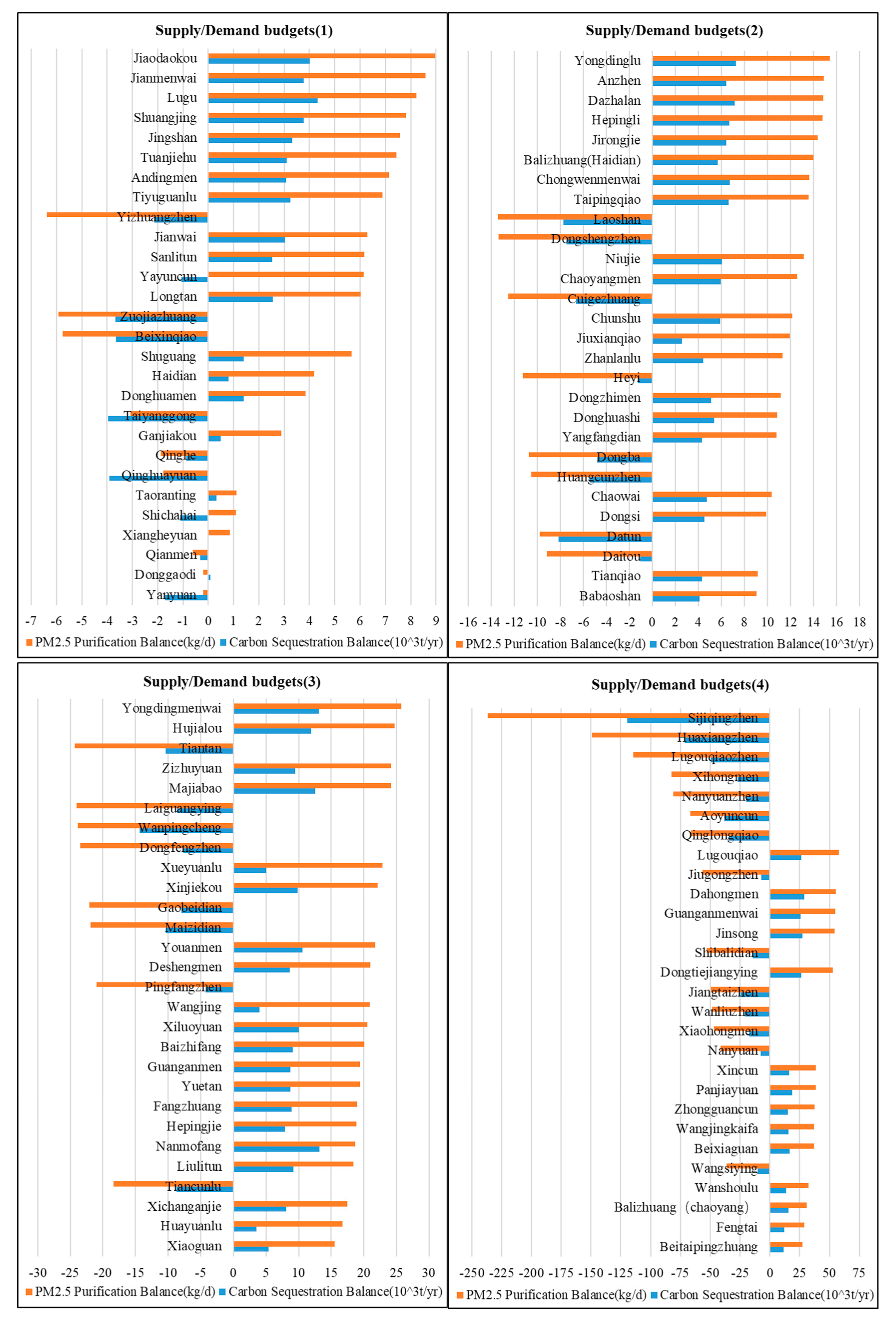Landscape Pattern Theoretical Optimization of Urban Green Space Based on Ecosystem Service Supply and Demand
Abstract
:1. Introduction
2. Materials and Pre-Processing
2.1. Study Area
2.2. Data Sources and Processing
2.2.1. GF-2 Imagery and Land Use Classification
2.2.2. Basic Data of Population Spatialization
2.2.3. PM2.5 Distribution
2.2.4. Leaf Area Index (LAI) Data
3. Methods
3.1. Mapping ES Supply
3.1.1. Assessment of UGS ES Supply
3.1.2. Mapping ES Supply at Two Scales
3.2. Mapping Human Demand of UGS ES
3.2.1. Indicator of UGS ES Demand
3.2.2. Mapping ES Demand at Two Scales
3.3. Mapping Budgets of ES Supply and Demand
3.4. UGS Optimization
4. Results
4.1. Evaluation Results of the UGS ES in Study Area
4.2. ES Supply and Demand at Administrative Units Scale
4.3. ES Supply and Demand at 1-m Grid Scale
4.4. Landscape Pattern Optimization of UGS
5. Discussion
5.1. Innovations of UGS Landscape Pattern Optimization Based on ES Evaluation
5.2. Limitations and Future Directions
6. Conclusions
Author Contributions
Funding
Data Availability Statement
Conflicts of Interest
References
- Niemelä, J. Ecology and urban planning. Biodivers. Conserv. 1999, 8, 119–131. [Google Scholar] [CrossRef]
- Michelle, K.; Jaime, F.; Thomas, M.; Charles, B. Urban Green Space and Its Impact on Human Health. Int. J. Environ. Res. Public Health 2018, 15, 445. [Google Scholar]
- Aronson, M.F.; Lepczyk, C.A.; Evans, K.L.; Goddard, M.A.; Lerman, S.B.; MacIvor, J.S.; Nilon, C.H.; Vargo, T. Biodiversity in the city: Key challenges for urban green space management. Front. Ecol. Environ. 2017, 15, 189–196. [Google Scholar] [CrossRef] [Green Version]
- Bowler, D.E.; Buyung-Ali, L.; Knight, T.M.; Pullin, A.S. Urban greening to cool towns and cities: A systematic review of the empirical evidence. Landsc. Urban Plan. 2010, 97, 1–155. [Google Scholar] [CrossRef]
- He, C.; Liu, Z.; Tian, J.; Ma, Q. Urban expansion dynamics and natural habitat loss in China: A multiscale landscape perspective. Glob. Chang. Biol. 2014, 20, 2886–2902. [Google Scholar] [CrossRef] [PubMed]
- Jin, X.; Dong, S.; Zhou, C.; Li, Y.; Li, Z. Ecological environmental problems in Chinese cities. Urban Cities 2009, 9, 5–10. (In Chinese) [Google Scholar]
- Wang, B.; Liu, Z.; Mei, Y.; Li, W. Assessment of Ecosystem Service Quality and Its Correlation with Landscape Patterns in Haidian District, Beijing. Int. J. Environ. Res. Public Health 2019, 16, 1248. [Google Scholar] [CrossRef] [PubMed] [Green Version]
- Goldstein, J.H.; Caldarone, G.; Duarte, T.K.; Ennaanay, D.; Hannahs, N.; Mendoza, G.; Polasky, S.; Wolny, S.; Daily, G.C. Integrating ecosystem-service tradeoffs into land-use decisions. Proc. Natl. Acad. Sci. USA 2012, 109, 7565–7570. [Google Scholar] [CrossRef] [PubMed] [Green Version]
- Jack, B.K.; Kousky, C.; Sims, K.R.E. Designing payments for ecosystem services: Lessons from previous experience with incentive-based mechanisms. Proc. Natl. Acad. Sci. USA 2008, 105, 9465–9470. [Google Scholar] [CrossRef] [Green Version]
- Bouwma, I.; Schleyer, C.; Primmer, E.; Winkler, K.J.; Berry, P.; Young, J.; Carmen, E.; Spulerova, J.; Bezak, P.; Preda, E. Adoption of the ecosystem services concept in EU policies. Ecosyst. Serv. 2017, 29, 213–222. [Google Scholar] [CrossRef]
- Woodruff, S.C.; Bendor, T.K. Ecosystem services in urban planning: Comparative paradigms and guidelines for high quality plans. Landsc. Urban Plan. 2016, 152, 90–100. [Google Scholar] [CrossRef]
- Lam, S.T.; Conway, T.M. Ecosystem services in urban land use planning policies: A case study of Ontario municipalities. Land Use Policy. 2018, 77, 641–651. [Google Scholar] [CrossRef]
- Wackernagel, M. Our Ecological Footprint: Reducing Human Impact on the Earth; New Society Publishers: Gabriola, BC, Canada, 1996. [Google Scholar]
- Villamagna, A.M.; Angermeier, P.L.; Bennett, E.M. Capacity, pressure, demand, and flow: A conceptual framework for analyzing ecosystem service provision and delivery. Ecol. Complex. 2013, 15, 114–121. [Google Scholar] [CrossRef]
- Schröter, M.; Barton, D.N.; Remme, R.P.; Hein, L. Accounting for capacity and flow of ecosystem services: A conceptual model and a case study for Telemark, Norway. Ecol. Indic. 2014, 36, 539–551. [Google Scholar] [CrossRef]
- Burkhard, B.; Kroll, F.; Nedkov, S.; Müller, F. Mapping ecosystem service supply, demand and budgets. Ecol. Indic. 2012, 21, 17–29. [Google Scholar] [CrossRef]
- Geijzendorffer, I.R.; Martin-Lopez, B.; Roche, P.K. Improving the identification of mismatches in ecosystem services assessments. Ecol. Indic. 2015, 52, 320–331. [Google Scholar] [CrossRef]
- Wu, Q.; Hongqing, L.; Rusong, W.; Juergen, P.; Yong, H.; Min, W.; Bihui, W.; Zhen, W. Monitoring and predicting land use change in Beijing using remote sensing and GIS. Landsc. Urban Plan. 2006, 78, 322–333. [Google Scholar] [CrossRef]
- Xie, Y.; Fang, C.; Lin, G.C.S.; Gong, H.; Qiao, B. Tempo-Spatial Patterns of Land Use Changes and Urban Development in Globalizing China: A Study of Beijing. Sensors 2007, 7, 2881–2906. [Google Scholar] [CrossRef] [Green Version]
- Li, F.; Wang, R.; Paulussen, J.; Liu, X. Comprehensive concept planning of urban greening based on ecological principles: A case study in Beijing, China. Landsc. Urban Plan. 2005, 72, 325–336. [Google Scholar] [CrossRef]
- D’Oleire-Oltmanns, S.; Coenradie, B.; Kleinschmit, B. An Object-Based Classification Approach for Mapping Migrant Housing in the Mega-Urban Area of the Pearl River Delta (China). Remote Sens. 2011, 3, 1710–1723. [Google Scholar] [CrossRef] [Green Version]
- Araya, Y.H.; Cabral, P. Analysis and Modeling of Urban Land Cover Change in Setúbal and Sesimbra, Portugal. Remote Sens. 2010, 2, 1549–1563. [Google Scholar] [CrossRef] [Green Version]
- Bakillah, M.; Liang, M.L.; Mobasheri, A.; Arsanjani, J.J.; Zipf, A. Fine-resolution population mapping using OpenStreetMap points-of-interest. Int. J. Geogr. Inf. Sci. 2014, 28, 1940–1963. [Google Scholar] [CrossRef]
- Kangning, L.; Yunhao, C.; Ying, L. The Random Forest-Based Method of Fine-Resolution Population Spatialization by Using the International Space Station Nighttime Photography and Social Sensing Data. Remote Sens. 2018, 10, 1650. [Google Scholar]
- Wang, Y.D.; Gu, Y.Y.; Dou, M.X.; Qiao, M.L. Using Spatial Semantics and Interactions to Identify Urban Functional Regions. Isprs Int. J. Geo-Inf. 2018, 7, 130. [Google Scholar] [CrossRef] [Green Version]
- Zhai, W.; Bai, X.; Shi, Y.; Han, Y.; Peng, Z.R.; Gu, C. Beyond Word2vec: An approach for urban functional region extraction and identification by combining Place2vec and POIs. Comput. Environ. Urban. 2019, 74, 1–12. [Google Scholar] [CrossRef]
- Helbich, M.; Amelunxen, C.; Neis, P.; Zipf, A. Comparative spatial analysis of positional accuracy of openstreetmap and proprietary beodata. Proc. GI_Forum. 2012, 4, 221–230. [Google Scholar]
- Elvidge, C.D.; Baugh, K.E.; Dietz, J.B.; Bland, T.; Sutton, P.C.; Kroehl, H.W. Radiance Calibration of DMSP-OLS Low-Light Imaging Data of Human Settlements. Remote Sens. Environ. 1999, 68, 77–88. [Google Scholar]
- Sutton, P. Modeling population density with night-time satellite imagery and GIS. Comput. Environ. Urban. 1997, 21, 227–244. [Google Scholar] [CrossRef]
- Sun, P.; Liu, S.; Liu, J.; Li, C.; Lin, Y.; Jiang, H. Derivation and validation of leaf area index maps using NDVI data of different resolution satellite imageries. Acta Ecol. Sin. 2006, 26, 3826–3834. (In Chinese) [Google Scholar]
- Yu, X.; Shuo, W.; Na, L.; Gaodi, X.; Chunxia, L.; Biao, Z.; Changshun, Z. Atmospheric PM2.5 removal by green spaces in Beijing. Resour. Sci. 2015, 37, 1149–1155. [Google Scholar]
- Affek, A.; Degorski, M.; Wolski, J.; Solon, J.; Kowalska, A.; Roo-Zielinska, E.; Grabinska, B.; Kruczkowska, B.; Affek, A.; Degorski, M.; et al. CICES V5.1 classification. In Ecosystem Service Potentials and Their Indicators in Postglacial Landscapes; Elsevier: Amsterdam, The Netherlands, 2020; pp. 113–115. [Google Scholar]
- Gill, E.G. The effects of air pollution on the respiratory tract. Ann. Otol. Rhinol. Laryngol. 1949, 58, 1141–1147. [Google Scholar] [CrossRef]
- Li, F.; Liu, X.; Hu, D.; Wang, R.; Yang, W.; Li, D.; Zhao, D. Measurement indicators and an evaluation approach for assessing urban sustainable development: A case study for China’s Jining City. Landsc. Urban Plan. 2009, 90, 134–142. [Google Scholar] [CrossRef]
- Wang, Z.; Zhang, S.; Wang, X.; Yang, Y. Evaluation of Environmental Purification Service for Urban Green Space in Nanjing. Nat. Environ. Pollut. Tech. 2015, 14, 1019–1025. [Google Scholar]
- Bae, J.; Ryu, Y. Land use and land cover changes explain spatial and temporal variations of the soil organic carbon stocks in a constructed urban park. Landsc. Urban Plan. 2015, 136, 57–67. [Google Scholar] [CrossRef]
- Jo, H.K. Impacts of urban greenspace on offsetting carbon emissions for middle Korea. J. Environ. Manag. 2002, 64, 115–126. [Google Scholar] [CrossRef]
- Lee, D.; Han, P.J.; Park, C. Estimation of Carbon Uptake for Urban Green Space: A Case of Seoul. J. Environ. Impact Assess. 2010, 19, 607–615. [Google Scholar]
- Yoon, T.K.; Seo, K.W.; Park, G.S.; Son, Y.M.; Son, Y. Surface Soil Carbon Storage in Urban Green Spaces in Three Major South Korean Cities. Forests 2016, 7, 115. [Google Scholar] [CrossRef] [Green Version]
- Escobedo, F.J.; Nowak, D.J. Spatial heterogeneity and air pollution removal by an urban forest. Landsc. Urban Plan. 2009, 90, 102–110. [Google Scholar] [CrossRef]
- Tallis, M.; Taylor, G.; Sinnett, D.; Freer-Smith, P. Estimating the removal of atmospheric particulate pollution by the urban tree canopy of London, under current and future environments. Landsc. Urban Plan. 2011, 103, 129–138. [Google Scholar] [CrossRef]
- Nowak, D.J.; Hirabayashi, S.; Bodine, A.; Hoehn, R. Modeled PM2.5 removal by trees in ten U.S. cities and associated health effects. Environ. Pollut. 2013, 178, 395–402. [Google Scholar] [CrossRef]
- Derkzen, M.L.; van Teeffelen, A.J.A.; Verburg, P.H. REVIEW Quantifying urban ecosystem services based on high-resolution data of urban green space: An assessment for Rotterdam, The Netherlands. J. Appl. Ecol. 2015, 52, 1020–1032. [Google Scholar] [CrossRef]
- Zhang, Y.; Li, Q.; Huang, H.; Wu, W.; Du, X.; Wang, H.J.R.S. The Combined Use of Remote Sensing and Social Sensing Data in Fine-Grained Urban Land Use Mapping: A Case Study in Beijing, China. Remote Sens. 2017, 9, 865. [Google Scholar] [CrossRef] [Green Version]
- Paetzold, A.; Warren, P.H.; Maltby, L.L. A framework for assessing ecological quality based on ecosystem services. Ecol. Complex. 2010, 7, 273–281. [Google Scholar] [CrossRef]
- Kroll, F.; Muller, F.; Haase, D.; Fohrer, N. Rural-urban gradient analysis of ecosystem services supply and demand dynamics. Land Use Policy 2012, 29, 521–535. [Google Scholar] [CrossRef]
- Yan, Y.; Zhu, J.; Wu, G.; Zhan, Y. Review and prospective applications of demand, supply, and consumption of ecosystem services. Acta Ecol. Sinica 2017, 37, 2489–2496. (In Chinese) [Google Scholar]
- Ala-Hulkko, T.; Kotavaara, O.; Alahuhta, J.; Hjort, J. Mapping supply and demand of a provisioning ecosystem service across Europe. Ecol. Indic. 2019, 103, 520–529. [Google Scholar] [CrossRef]
- Wang, J.; Zhai, T.L.; Lin, Y.F.; Kong, X.S.; He, T. Spatial imbalance and changes in supply and demand of ecosystem services in China. Sci. Total Environ. 2019, 657, 781–791. [Google Scholar] [CrossRef]
- Shen, Y.A.; Sun, F.; Che, Y.Y. Public green spaces and human wellbeing: Mapping the spatial inequity and mismatching status of public green space in the Central City of Shanghai. Urban For. Urban Green. 2017, 27, 59–68. [Google Scholar] [CrossRef]
- Xing, L.J.; Liu, Y.F.; Liu, X.J.; Wei, X.J.; Mao, Y. Spatio-temporal disparity between demand and supply of park green space service in urban area of Wuhan from 2000 to 2014. Habitat Int. 2018, 71, 49–59. [Google Scholar] [CrossRef]
- Ji, Y.-W.; Zhang, L.; Liu, J.; Zhong, Q.; Zhang, X. Optimizing Spatial Distribution of Urban Green Spaces by Balancing Supply and Demand for Ecosystem Services. J. Chem. 2020, 2020. [Google Scholar] [CrossRef] [Green Version]
- Gomez-Baggethun, E.; Barton, D.N. Classifying and valuing ecosystem services for urban planning. Ecol. Econ. 2013, 86, 235–245. [Google Scholar] [CrossRef]
- Wilkerson, M.L.; Mitchell, M.G.E.; Shanahan, D.; Wilson, K.A.; Ives, C.D.; Lovelock, C.E.; Rhodes, J.R. The role of socio-economic factors in planning and managing urban ecosystem services. Ecosyst. Serv. 2018, 31, 102–110. [Google Scholar] [CrossRef]












| Green Type | LAI-NDVI Algorithm |
|---|---|
| Tree | [30] |
| Shrub | [30] |
| Grassland | [31] |
| Classification | Characteristics | UGS Optimization Proposal |
|---|---|---|
| Ⅰ: Lack of green space | The green rate of the administrative unit is lower than the overall green rate of the study area, which can meet the demand by increasing the green area to the overall green rate. | Increase green space according to ES demand. |
| Ⅱ: Unreasonable green space structure | The green rate of the administrative unit has reached the level of the study area; however, there is still an imbalance between ES supply and demand. | Adjust the existing green space structure, such as building composite green spaces. |
| Ⅲ: Comprehensive | The green rate of the administrative unit is lower than that of the study area and remains unable to meet the demand by increasing the green area to the overall green rate. | Increase green space and adjust existing green space structures. |
| Area (km2) | Percentage of Total Area (%) | PM2.5 Purification Supply | Carbon Sequestration Supply | |||
|---|---|---|---|---|---|---|
| Total (kg/d) | Per Unit Area (mg/m2∙d) | Total (t/yr.) | Per Unit Area (kg/m2∙yr.) | |||
| UGS | 266.78 | 39.09 | 3441.58 | 12.90 | 1,699,900.83 | 6.37 |
| Tree | 96.63 | 14.16 | 1559.49 | 16.13 | 1,028,493,45 | 10.64 |
| Shrub | 98.40 | 14.42 | 1158.48 | 11.77 | 659,280.00 | 6.70 |
| Grassland | 71.71 | 10.51 | 723.61 | 10.09 | 12,190.70 | 0.17 |
| Classification | Sub-Districts |
|---|---|
| Ⅰ: Lack of green space | Donghuamen; Jiuxianqiao; Jianwai; Yangfangdian; Shuangjing; Babaoshan; Ganjiakou; Jianmenwai; Lugu; Zhanlanlu; Donggaodi |
| Ⅱ: Unreasonable green space structure | Taoranting; Shuguang; Wangjing; Hepingli; Longtan; Hepingjie; Anzhen; Wangjingkaifa |
| Ⅲ: Comprehensive | Xincun; Haidian; Balizhuang (Haidian); Jirongjie; Xueyuanlu; Fengtai; Tiyuguanlu; Huayuanlu; Sanlitun; Taipingqiao; Xichanganjie; Andingmen; Nanmofang; Xinjiekou; Tianqiao; Wanshoulu; Jingshan; Beitaipingzhuang; Zizhuyuan; Yuetan; Lugouqiao; Chaowai; Beixiaguan; Xiaoguan; Deshengmen; Dongzhimen; Jiaodaokou; Donghuashi; Liulitun; Youanmen; Baizhifang; Dongsi; Zhongguancun; Tuanjiehu; Majiabao; Yongdingmenwai; Balizhuang (Chaoyang); Dazhalan; Niujie; Fangzhuang; Hujialou; Dahongmen; Guanganmen; Xiluoyuan; Yongdinglu; Chaoyangmen; Guanganmenwai; Chongwenmenwai; Dongtiejiangying; Chunshu; Panjiayuan; Jinsong |
Publisher’s Note: MDPI stays neutral with regard to jurisdictional claims in published maps and institutional affiliations. |
© 2021 by the authors. Licensee MDPI, Basel, Switzerland. This article is an open access article distributed under the terms and conditions of the Creative Commons Attribution (CC BY) license (https://creativecommons.org/licenses/by/4.0/).
Share and Cite
Liu, Q.; Tian, Y.; Yin, K.; Zhang, F.; Huang, H.; Chen, F. Landscape Pattern Theoretical Optimization of Urban Green Space Based on Ecosystem Service Supply and Demand. ISPRS Int. J. Geo-Inf. 2021, 10, 263. https://0-doi-org.brum.beds.ac.uk/10.3390/ijgi10040263
Liu Q, Tian Y, Yin K, Zhang F, Huang H, Chen F. Landscape Pattern Theoretical Optimization of Urban Green Space Based on Ecosystem Service Supply and Demand. ISPRS International Journal of Geo-Information. 2021; 10(4):263. https://0-doi-org.brum.beds.ac.uk/10.3390/ijgi10040263
Chicago/Turabian StyleLiu, Qinqin, Yichen Tian, Kai Yin, Feifei Zhang, Huiping Huang, and Fangmiao Chen. 2021. "Landscape Pattern Theoretical Optimization of Urban Green Space Based on Ecosystem Service Supply and Demand" ISPRS International Journal of Geo-Information 10, no. 4: 263. https://0-doi-org.brum.beds.ac.uk/10.3390/ijgi10040263





